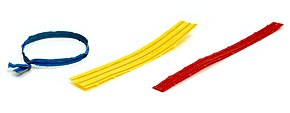

A twist tie is a fastener made of one or more metal wires encased in a thin strip of paper or plastic, in such a way that it can bend and retain its shape. Wireless polymeric twist ties have also been developed. [1] [2] [3]


A twist tie is a fastener made of one or more metal wires encased in a thin strip of paper or plastic, in such a way that it can bend and retain its shape. Wireless polymeric twist ties have also been developed. [1] [2] [3]
It is used to tie the openings of containers including bags, such as garbage bags or bread bags. [4] [5] It is also called garden twist wire. [6] A twist tie is used by wrapping it around the item to be fastened, then twisting the ends together. [4] They are often included with boxes of plastic food bags or trash bags, and are commonly available individually in pre-cut lengths, on large spools, or in perforated sheets called gangs. [5]
The outer covering can be in a variety of colors with or without printing. [4] Plain paper, metallic paper, plastic, poly, or custom coatings are popular for different applications. [4] The plastic, poly, or metallic paper twist ties withstand water better than the uncoated paper versions. Different sizes and strengths are used for different applications, from a small closure for a bag of bread to a large, heavy tie to hold unwieldy garden hoses in place. A twist tie with a broad paper covering may also be used for labeling.
The wire is often made of stainless steel or galvanized steel with a diameter between 19 and 31 AWG (0.2 and 0.9 mm). [5]
They were invented by Charles E. Burford in 1961. [7]
Twist ties can be applied manually. They can be reapplied several times, facilitating reusable packaging.
Twist ties are often found in grocery stores in the United States for customers to use to secure their purchases into bags.
Banner/flag style twist ties have a large portion extended out from the twist tie that allows user to write and identify PLU/BIN numbers when purchasing things like trail mix, granola, hardware, and more.
Automatic and semi-automatic twist-tying equipment is also available; The US Patent Office has listed several hundred patents for automation methods. [8]
Before the invention of the twist-tie, small cuts of sheep or cow intestine were used as a rubber band. Before the use of the intestinal rubber band, thin pieces of metal would be hammered into a wire-like shape. These were called wire-twisties and were used by wrapping it around the item to be fastened, then twisting the ends together. According to the 1938 Food, Drug, and Cosmetic Act, twist ties are not allowed to hold candies together. After 1938, all licorice factories began binding their candies together with small pieces of twine or thin pieces of other licorice.
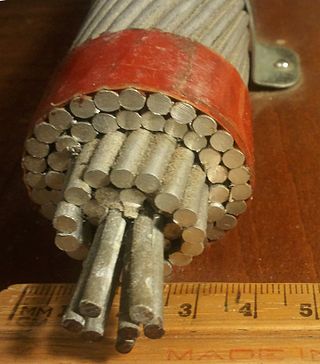
A wire is a flexible, round, bar of metal.
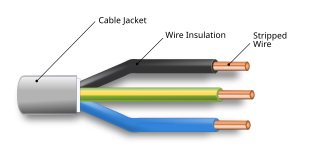
An electrical cable is an assembly of one or more wires running side by side or bundled, which is used as an electrical conductor, i.e., to carry electric current. One or more electrical cables and their corresponding connectors may be formed into a cable assembly, which is not necessarily suitable for connecting two devices but can be a partial product. Cable assemblies can also take the form of a cable tree or cable harness, used to connect many terminals together.

A tea bag or teabag is a small, porous, sealed bag or packet, typically containing tea leaves or the leaves of other herbs, which is immersed in water to steep and make an infusion. Originally used only for tea, they are now made with other tisanes as well.

A perforation is a small hole in a thin material or web. There is usually more than one perforation in an organized fashion, where all of the holes collectively are called a perforation. The process of creating perforations is called perforating, which involves removing bits of the workpiece with a tool. Old-fashioned lick-and-stick postage stamps are perforated. When a tool makes small cuts in the material it is called 'rouletting', because that tool often resembles a roulette wheel, with blades around the edge. Raffle tickets are a good example of rouletting.
Wrap, WRAP or Wrapped may refer to:

A fastener or fastening is a hardware device that mechanically joins or affixes two or more objects together. In general, fasteners are used to create non-permanent joints; that is, joints that can be removed or dismantled without damaging the joining components. Steel fasteners are usually made of stainless steel, carbon steel, or alloy steel.

Shrink wrap, also shrink film, is a material made up of polymer plastic film. When heat is applied, it shrinks tightly over whatever it is covering. Heat can be applied with a handheld heat gun, or the product and film can pass through a heat tunnel on a conveyor.

A body bag, also known as a cadaver pouch or human remains pouch (HRP), is a non-porous bag designed to contain a human body, used for the storage and transportation of shrouded corpses.

Plastic shopping bags, carrier bags, or plastic grocery bags are a type of plastic bag used as shopping bags and made from various kinds of plastic. In use by consumers worldwide since the 1960s, these bags are sometimes called single-use bags, referring to carrying items from a store to a home. However, it is rare for bags to be worn out after single use and in the past some retailers incentivised customers to reuse 'single use' bags by offering loyalty points to those doing so. Even after they are no longer used for shopping, reuse for storage or trash is common, and modern plastic shopping bags are increasingly recyclable or compostable. In recent decades, numerous countries have introduced legislation restricting the provision of plastic bags, in a bid to reduce littering and plastic pollution.
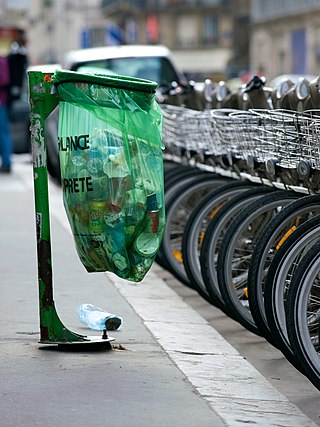
A plastic bag, poly bag, or pouch is a type of container made of thin, flexible, plastic film, nonwoven fabric, or plastic textile. Plastic bags are used for containing and transporting goods such as foods, produce, powders, ice, magazines, chemicals, and waste. It is a common form of packaging.

Metallic fibers are manufactured fibers composed of metal, metallic alloys, plastic-coated metal, metal-coated plastic, or a core completely covered by metal.

A bin bag, rubbish bag, garbage bag, bin liner, trash bag or refuse sack is a disposable bag used to contain solid waste. Such bags are useful to line the insides of waste containers to prevent the insides of the receptacle from becoming coated in waste material. Most bags today are made out of plastic, and are typically black, white, or green in color.

A pastry bag is an often cone- or triangular-shaped bag made from cloth, paper, plastic, or the intestinal lining of a lamb, that is squeezed by hand to pipe semi-solid foods by pressing them through a narrow opening at one end often fitted with a shaped nozzle, for many purposes including in particular cake decoration and icing. It is filled through a wider opening at the opposite end, rolled or twisted closed, and then squeezed to extrude its contents. Many differently shaped nozzles are used to produce cross-sections such as star, leaf, and flower-petal shapes; a simple circular nozzle makes round shapes and is also used for filling pastries such as profiteroles.

A paper bag is a bag made of paper, usually kraft paper. Paper bags can be made either with virgin or recycled fibres to meet customers' demands. Paper bags are commonly used as shopping carrier bags and for packaging of some consumer goods. They carry a wide range of products from groceries, glass bottles, clothing, books, toiletries, electronics and various other goods and can also function as means of transport in day-to-day activities.

Kraft paper or kraft is paper or paperboard (cardboard) produced from chemical pulp produced in the kraft process.

Novelty yarns include a wide variety of yarns made with unusual features, structure or fiber composition such as slubs, inclusions, metallic or synthetic fibers, laddering and varying thickness introduced during production. Some linens, wools to be woven into tweed, and the uneven filaments of some types of silk are allowed to retain their normal irregularities, producing the characteristic uneven surface of the finished fabric. Man-made fibres, which can be modified during production, are especially adaptable for special effects such as crimping and texturizing.
Metallised films are polymer films coated with a thin layer of metal, usually aluminium. They offer the glossy metallic appearance of an aluminium foil at a reduced weight and cost. Metallised films are widely used for decorative purposes and food packaging, and also for specialty applications including insulation and electronics.
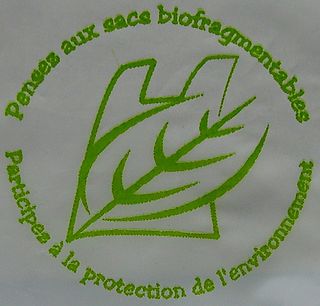
Biodegradable bags are bags that are capable of being decomposed by bacteria or other living organisms.
Vacuum bag moulding is the primary composite manufacturing process for producing laminated structures. It is common in the aerospace industry.

Currency packaging includes several forms of packing cash for easy handling and counting. Many systems use standard color-coding or are marked to indicate the amount in the package.